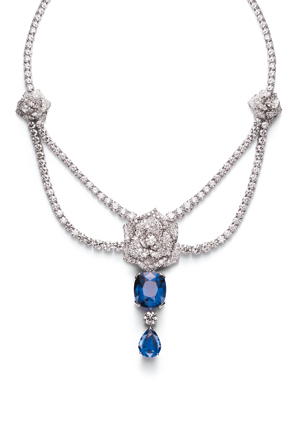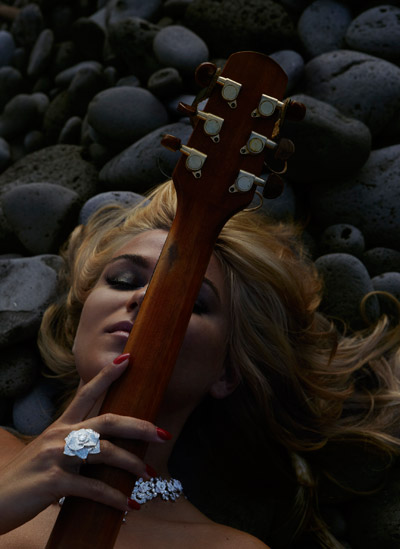Press release
For Piaget, the rose is an emblem. Reigning supreme in its collections, it has many stories to tell; stories of love and passion. In 1982, a new rose with an intense colour and fragrance was named after Yves Piaget. It became known as the Yves Piaget Rose and founded the link between watchmaker and jeweller and the most symbolic flowers.
Thirty years later, the rose is as popular as ever at Piaget. Talent and expertise are joined in the celebration of the rose. Working in gold and diamonds, Piaget's designers and craftsmen exquisitely created the Piaget Rose collection. But the rose has inspired another talent; that of a glamorous artist who has created her own version of the most famous love song of our time. A romantic melody portraying the words of passion, life, romance and roses: 'La Vie en Rose'.
Creating a version of this classic song by Edith Piaf is not easy. Few artists have been able to render a modern remake of 'La Vie en Rose' while retaining its magic and charm.
For Melody Gardot, a musician with an exceptional voice, 'La Vie en Rose' has always held a special place in her mind and imagination.

"'La Vie en Rose' represents a lot of things for me, but mostly it represents my feelings towards my guitar. What it has brought into my life and how things have changed. 'La Vie en Rose' is like food for my musical garden. For me, 'La Vie en Rose' like music, has allowed me to reinvent myself, and even to change into somebody else completely. Waking up in the morning knowing you can't move or speak, as was the case after my accident, can be difficult and painful. But your imagination feeds on everything that will happen in the future. We all need a new lease on life from time to time!" Melody Gardot.
Inspired by her own life experiences and fed by her musical curiosity, Melody Gardot brings a new emotional experience to this song. Its seductive, glamorous and elegant feel reflects the Piaget style. Nourished by Melody Gardot's voice and artistic talent, the Piaget Rose collection is now in bloom, offering all who wear it the promise of metamorphosis. Life is certainly a bed of roses with Piaget.
Get a sneak peak at La Vie en Rose by Melody Gardot on rose.piaget.com on 16 April 2012. It will also feature as a bonus track on the special edition of her 'The Absence' album, on sale from 28 May, and as a music video at the end of June.


MELODY GARDOT
The Absence
Following an extensive two-year world tour in support of her highly successful major label debut, My One and Only Thrill, Melody Gardot was restless and ready for new adventure. Setting out on her own, she continued her travels around the world meeting new people and experiencing new cultures. From the deserts of Morocco to the streets of Lisboa, from the tango bars of Buenos Aires to the beaches of Brazil, her new record, The Absence, captures the essence of each of these exotic locales, while at the same time remaining quintessentially Melody Gardot.
In the summer of 2010, Melody took a last minute trip to Marrakech. On an overnight trip to the desert, she had something of a revelation:
“So many languages and so many cultures and yet I was taken by how similar the spirit of music is the world over.”
Melody's next stop was Lisbon. Ensconced with her piano in a crumbling palazzo in the old city centre of Alfama, she threw herself into the indefinable Portuguese sentiment of loss and longing, saudade. Songs like the aptly titled “Lisboa” offer a glimpse of her stay there and the musical sounds of the streets – children playing, church bells, a singer on the corner. She learned the language, explored the fado clubs and immersed herself in songwriting.
From Lisbon, Buenos Aires beckoned. An avid tango dancer, she found herself in the historic San Telmo neighborhood, the sound of tango music literally filling the streets. Drawing from the dramatic rhythm and spirit of the tango she was inspired to write songs like “Goodbye” and the brooding “So We Meet Again My Heartache”. The exotic street culture of Buenos Aires provided a backdrop for delving further into the sentiment of saudade.
At last, Gardot was ready to see the sun and explore the music of Brazil. She chartered a sailboat and asked the Captain to steer north. A month at sea along the Brazilian coast, Melody found just what she needed. The vibrant colour of the landscape, the smiles of the people and the passion of samba carried Gardot from the depths of longing and sadness. It was here that songs like “Mira” and “Yemanja” were born.
“A lot the stories on the record come from my experiences – but also from the observation of people, living with them, the sadness and joy that came about in little moments. It was really a mutual connection.”
“To experience love in a different way, to understand what love is in a community is to recognize how people really hold themselves together. It was a huge shift for me, it bought me close - especially in Brazil – to people who celebrate through music.”
Melody carried all of these experiences, knowledge and music with her back to the States where she met with producer, composer and guitarist, Heitor Pereira.
“It was a beautiful connection," she says of her meeting with Pereira. "I had reached the point of not knowing what to do. All the music, somehow through the course of those months spent travelling, had welled up inside me with no way to get out. I needed a partner - a collaborator, and a bit of genius in his own right. Someone crazy enough to understand how serious I am when I say, 'I want to play palm leaves and a washboard' - and make it work.”
Heitor Pereira, renowned for his work as a film composer (Despicable Me, Its Complicated, From Prada to Nada) and world-class session guitarist (Sting, Seal, Caetano Veloso), turned out to be the perfect partner for Melody. The Brazilian-born, US-based artist shared Melody's enthusiasm for driving off the beaten path of Western pop, jazz, blues and soul. And he was as adventurous as Melody when it came to inventive sonic ideas.

The two worked together on songs like “Se Voce Me Ama” and “Amalia” which they co-wrote. Heitor plays guitar on the record and can be heard singing on “Se Voce Me Ama”. He also composed all the orchestral arrangements on the album. The all-star band is rounded out by John Leftwich (bass), Paulihno DaCosta (percussion), Jim Keltner and Peter Erskine (drums).
It took a year of travelling the world for Melody to find her inspiration for The Absence. It is a collection of many musical colours wrapped in the unique and expressive style that is Melody Gardot. As she embarks on another global tour to support her third album, it is time for us to share the music: the loss, the longing and finally the joy that she has discovered on her journey.

MELODY GARDOT
Biography
The finest musicians don't always make the most noise. At 22, singer-songwriter Melody Gardot understands the value of subtlety and understatement. It's what helps to make her debut album, ‘Worrisome Heart', sound simultaneously familiar, yet utterly surprising.
For Melody, music is something that helps her relax, meditate, and look inwards. “I gravitate towards soothing music, often genres that are soft and somewhat unassuming. Music can do wonders for your spirit especially when it's the kind that calms you.”
It's an approach that sets her a little apart from most of her contemporaries, who are more likely to be listening to indie-rock or hiphop. But the results of her preferences speak for themselves. The title track, ‘Worrisome Heart', is a slow, fluid blues, sung with beyond-her-years weariness by Gardot as horns and upright bass evoke a slow voyage down the Mississippi. In ‘Gone', simple guitar and violin catch the haunting spirit of her lovelorn lyric while smoky organ, lazy horns and light, jazzy drums lend a sense of simmering eroticism to ‘Quiet Fire'.
Gardot's presence both lyrically and musically lend themselves to someone far beyond her years, yet she had her first introduction to the world of music only a short while ago when she earned some spare cash by playing in piano bars. She was just 16.
“Music wasn't something I thought I'd wind up doing,” she admits. “I played on Fridays and Saturdays, for four hours a night. I wasn't your typical player though because I only played music that I liked. A mix of things old and new, I played everything from the Mamas & The Papas to Duke Ellington to Radiohead.”
It was only after an automobile accident while riding her bicycle home that the path Gardot has set out on began to change. Struck suddenly by a vehicle, she suffered multiple pelvic fractures, spinal, nerve and head injuries. Several of the effects have left their marks in various ways such as requiring Gardot to carry a cane and sport shaded glasses to combat residual photosensitivity.
Since Gardot had dabbled in music the past, during a follow up visit one day, her doctor suggested she try music therapy as a means for recovery. Specifically, he believed it would help her with her cognitive problems as music has been known to help repair neuropathways in the brain after severe trauma. However, her doctor can't have imagined the far-reaching consequences. While still unable to walk, Melody began writing and recording songs on a portable multitrack recorder at her bedside.
“I started recording the songs as a way to remember what I'd done; I had really bad short-term memory problems,” she explains. “At the end of the day I couldn't remember the beginning”.
These songs she wrote during her recuperation were released as a six-song EP called Some Lessons: The Bedroom Sessions. After hearing it, one critic commented that it was “a trick of alchemy that awful pain and uncertainty can give rise to such bold and striking music.”
A new version of the title tune from Some Lessons appears on ‘Worrisome Heart', alongside a batch of new songs which offer thrilling evidence of Gardot's rapid development as a songwriter. She has added more instruments and tonal colours than she used on the EP, but the arrangements are always geared to make the most of the delicious intimacy of her voice and lyrics.
Although Melody claims she was never a fanatical music buff with a vast and esoteric record collection, she knows how to get the results she wants with her own songs.
“I had ideas about how I wanted things to go. In the studio cutting ‘Worrisome Heart', I remember standing in the recording booth and saying to the horn guys ‘can you make it sleazier?' They said ‘yeah! Sleazy man, that's cool!' It may not have been the most musical way to put it but they knew exactly what I meant!” she laughs.
You can tell she's doing something right, because nobody is quite sure how to define her music. There have been comparisons with Norah Jones or Diana Krall, and she was recently invited by Herbie Hancock to sing Joni Mitchell's song Edith And The Kingpin for the Live From Abbey Road TV series. But equally her performances might evoke echoes of Peggy Lee or even Tom Waits.
So is her music jazz? Is it blues?
“I can understand why people hear the blues in the songs,” she reflects. “Even the chord structures are simple in nature and pure in their darkest places. People talk about jazz, but if you strip it all down it just comes down to one thing: it's all about the songs and the place where they originate. I've had a lot of heartbreak (hence the Worrisome Heart) and when you feel that so intensely you can't help but go there when the music calls for it. When people talk about singing the blues this is what they mean. It isn't a style or a genre; it's a feeling. ”






